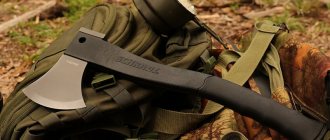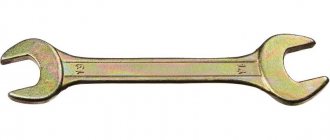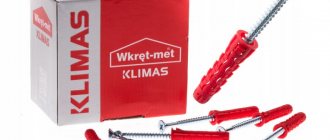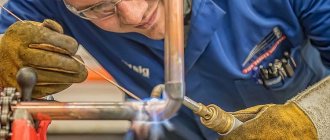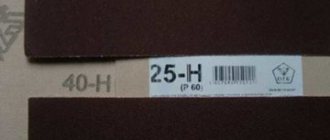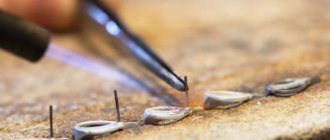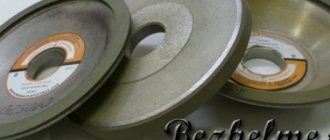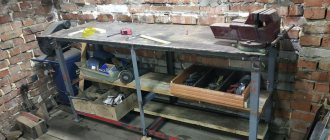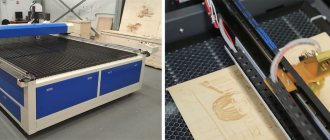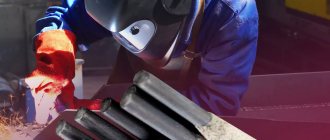Concept and main characteristics
A wrench is a tool designed to connect and disconnect a threaded fastening joint by rotating threaded parts - nuts, bolts, pipes, etc.
To tighten (unscrew) a part, an external force is applied, created by human muscular force and applied to the object. The torque is equal to the product of the radius vector drawn from the axis of rotation to the point of application of the force and the force vector. An increase in torque is achieved by lengthening the length of the tool handle and increasing the maximum applied force, which directly depends on the physical capabilities of the person.
For the best transmission of torque, it is necessary that the working profile of the wrench fits tightly to the surface of the part, but does not damage it during the application of force and does not damage itself. The hardness of the working profile is achieved by making keys from a special material (tool steel with the addition of vanadium and chromium). The hardness of the working profile of the tool is standardized in national and international standardization systems.
One of the main parameters of a wrench is the size of the jaw - the distance between the jaws of the wrench or the width of the hole. The size is standardized and is measured in millimeters in the metric system. The everyday phrase “10 key” means that the distance between the jaws is 10 mm. In countries with the English system of measures, size is measured in inches. Dimensions and tolerances between jaws are also standardized in international and national standardization systems.
Socket wrench heads
A convenient option for using this type of tool. If we compare a set of socket wrenches and replacement heads, the latter occupy a more advantageous position due to their compactness and lower weight of the set. A wrench is included with the removable hexagons. It can be equipped with a ratchet that can be adjusted to move in one direction only. Sets of socket heads can be supplied in two versions: with a hole in the side walls and with an internal tetrahedron at the end of the heads.
The driver in the first case is a simple metal rod with the appropriate diameter. In the second version, it has a square end with a locking ball. A swivel joint and an extension rod are provided. A set of interchangeable heads can replace a universal hexagon socket wrench. This is the only head with a set of spring-loaded metal pins inside. The rods are able to move freely. Deepening, they cover a nut of any size and fix it when unscrewing or tightening.
Main types of classifications
All wrenches can be divided into two main groups: female and male. Tools of the first category with their working profile cover the part from its outer sides. Female wrenches include the most common open-end wrenches, gas wrenches, box wrenches, etc. Male wrenches, on the contrary, are placed in the hole of the part (slot), these include hexagons, star-shaped, Bristol, etc.
Also, all keys are usually divided into the following categories:
- Monolithic
Made from an all-metal structure with a constant working profile size.
- Composite
They consist of a handle and a socket in which interchangeable heads of different sizes are attached.
Pros and cons of a spanner wrench
A U-shaped open mouth is easier to manufacture, so simple horn tools are cheaper, but professionals for critical work prefer to purchase devices with a ring head, which are more expensive. The undeniable advantages of ring wrenches, which completely cover their higher cost:
- When using a spanning tool, the load is distributed more evenly over all six faces.
- Due to the fact that the contact spots are located at a distance from the corners, even a power spanner is capable of turning the head upon impact without significant crushing of the metal.
- The fastener head is held and fixed more securely.
- It is more convenient to work with spanners.
- The ring head has smaller dimensions.
- It is easier to equip the attachment device with a ratcheting mechanism.
Disadvantages of ring wrenches:
- The cost of such a tool is somewhat more expensive.
- A standard type spanner must be installed on the head from above, so its use requires more space to access the fasteners.
Kinds
There are a lot of types of wrenches, but not all of them are widely used in everyday life. A significant part of the varieties of such tools is used in special industries or in a professional environment. Therefore, we will describe only the main varieties of this tool.
Carob
The most common type of wrench. They got their name because their ends actually resemble animal horns. The open-end wrench has an open U-shaped mouth, its working profile covers the part from 2 or 3 sides.
The distance between the jaws at the two ends is different, which allows you to use one tool when working with nuts of different sizes. For better transmission of torque and increased range of use in hard-to-reach places, the axes of the open-end wrench heads are deviated by 15 °C relative to the longitudinal axis of the handle.
Carob one-sided
Single-sided open-end wrenches are quite rare in everyday life - they are usually used in production. To increase the torque, a pipe can be placed on the free end of the tool. Typically, such a tool has a large size between the jaws - from 36 to 65 mm.
Cap (ring)
Spanners have a working profile in the form of a closed ring with 6 or 12 edges.
Thanks to this design, a large contact area is achieved - the profile completely fits the working surface of the part, so it does not come off its edges. Typically, ring wrenches are double-sided with rings of different sizes within close ranges. A tool of this design is more convenient to use than an open-end wrench, since it can be rotated without lifting it from the part, without moving the jaw or intercepting the handle. Due to their smaller size, they are more convenient to store and transport.
The main disadvantage of the classic double-sided socket wrench is the difficulty of working in hard-to-reach places, since rotation requires free space.
In addition to double-sided ring wrenches, the following types of tools are available:
- Single-ended - a tube can be placed on the other end to increase torque.
- Curved - allow you to work in places with limited space.
- Impact sockets - allow you to tighten a part more strongly or, conversely, unscrew a rusty nut (much thicker than usual).
- With ratchet - also used when working in hard-to-reach places.
Combined
Combination wrenches are a design with two different ends: one open-end type and the other ring type. The working profiles of such a tool are used in various conditions, when it is convenient - a ring, in conditions of limited space - a horn jaw. Combination wrenches are always made with ends of the same size, for example, 13*13, 15*15, etc. There are varieties of combination wrenches with other tips, for example, open end and socket, but they are less common than the classic version.
End
Socket wrenches are used in specific conditions, most often in recesses when the nut is deeply recessed relative to the surface, which does not allow the use of conventional open-end or ring tools.
They are a tube whose inner surface of the edges has a hexagonal shape. There are two types:
- Direct
To impart torque, a perpendicularly located lever is used, inserted into the hole of the tool, for example, a screwdriver.
- Curved
They have an L-shape or T-shape, allowing rotation without the use of additional devices.
Expert opinion
Torsunov Pavel Maksimovich
Socket wrenches have a small torque, so they have received limited distribution. Quite often they are used when servicing cars; typical representatives of this type of tool are spark plugs, balloon wrenches, and cardan wrenches. The end tool can also be produced in various modifications: with a ratchet mechanism for easier access, in combined versions (cross barrels).
Adjustable
Adjustable wrenches are a modification of open-end wrenches that have variable dimensions due to changing the distance between the jaws of the ends. In Russia, keys of the Swedish type are most widespread; instruments of the American and French types are also widespread throughout the world.
The upper jaw of such a tool is usually fixed, the lower one is movable. The distance between them is adjusted via a worm gear. The tool is first applied to the part, after which the lower jaw is fixed in the desired position by rotating the worm gear.
Adjustable wrenches are universal - one tool can replace several open-end wrenches of similar dimensions. They also come in different sizes, the range of application is indicated on the handle of the tool. Another plus is the ability to work with nuts of non-standard sizes.
However, such keys are not without their drawbacks:
- Large head size, which affects ease of storage and transportation.
- A small amount of torque due to the presence of irremovable play between the jaws due to the mobility of the lower one.
It will not be possible to unscrew a tightly screwed nut with such a tool. Therefore, adjustable wrenches are usually used for low-intensity work and at home. Such a tool is poorly suited for professional work.
Pipe (gas)
A pipe wrench is considered one of the options for an adjustable wrench: it also has one fixed jaw and one movable jaw, adjustable using a screw gear. The main difference from the adjustable one is that the gas one has special notches on the inner surface of the jaws, which allow them to cover and hold the round surfaces of the pipes. It is also distinguished by the presence of a screw type transmission rather than a worm type.
In everyday life, pipe wrenches are often called plumbing or gas wrenches, since they are most often used to work with plumbing or gas pipes. Primarily, a tool of this type is intended for fixing and rotating pipes, however, due to its versatility, it can still be used when working with parts of any shape.
Expert opinion
Torsunov Pavel Maksimovich
Pipe wrenches do not require a hex nut profile and are capable of working with rounded parts. The torque of pipe wrenches is less than that of box wrenches. Another disadvantage of the tool is the possibility of damage to the working surface of the part due to the high pressure of the jaws on the metal. In general, gas wrenches are a rather crude tool, not intended for fine work.
Hexagons
The hexagonal (inbus) key is male, that is, in order to rotate it, it is placed in the slot of the part.
Hexagons are a steel rod that is L-shaped to facilitate rotation. The working profile is a head in the shape of a regular hexagon. Typically, hexagons are used when assembling/disassembling furniture; their head fits the slot of a confirmat (furniture self-tapping screw with a blunt end), which is used to connect wood parts (chipboard, MDF, solid wood, etc.). Hex sockets range in size from 1.5 to 24 mm and are usually sold in sets.
Star (Torx)
A variation of a male wrench with an asterisk (Torx) end. A popular format abroad, which has become widespread in Russia. The only difference from other male wrenches is the shape of the head, which is a six-pointed star (Torx format).
Typically, Torx is used in the repair of household appliances, mobile phones, and cars. They are marked with the index T with a number indicating the dimension. The smallest sizes (T5, T6) are found exclusively in cell phone repair kits. The maximum size is T50, which is equal to 8.83 mm.
Special
Non-sparking wrench.
Special wrenches have design and/or application features that sharply distinguish them from the main array of tools for tightening threaded connections. They are usually used in special types of production or for maintenance and repair of certain types of equipment.
In particular, special keys include:
- Intrinsically safe - made of steel with the addition of an alloying additive (aluminum or beryllium), used in industries with explosive atmospheres and does not produce a spark when dropped and in contact with metal.
- Ear-shaped - used for working with non-standard shaped bolts.
- Carriage type - designed for loosening round carriage-type nuts (with slots in the end part or holes).
- Extractors are tools for unscrewing damaged parts (nuts with worn edges, bolts with torn heads, etc.).
The familiar bicycle “family tools” are also special - tools with a combination of hexagonal holes and two carriage recesses.
What is a spanner?
This type of instrument differs favorably in design from horn devices with an open U-shaped mouth due to the more advanced shape of the working part. The spanner wrench has a ring profile with internal edges, which provides the most reliable coverage of the fastener head, which allows you to unscrew even heavily “stuck” nuts without tearing off the edges. This is the best choice for a person who constantly encounters problematic tight joints in plumbing work.
What does a spanner look like?
Mostly the head of this tool has a continuous ring profile, although there are modifications for plumbing work with an open ring, which facilitates access to fasteners in places where pipelines are installed. The number of edges in the standard version is 12 or 6. A universal box wrench is a more advanced model with an adjustable head, its size can be changed within established limits.
The shape of the handle affects ease of use and access to fasteners. The choice of profile depends on the application. The direct version is easier to manufacture and cheaper, but is not suitable for all situations. For this reason, bent-span wrenches are considered more practical and versatile to use for most jobs. A more expensive solution is a device with hinge-type heads, but it allows you to approach the nuts at an angle, even in an inconvenient place. We list the most popular varieties:
- Straight spanner.
- Crescent socket wrench.
- Bent spanner.
- Socket wrench with hinged type head.
How to choose the right tool: basic life hacks
The main criteria when choosing a tool are its purpose and size. There is no point in using a gas wrench when unscrewing nuts or using a hex wrench to work on a part with a star spline. When choosing a tool, you should know exactly how and why it will be used.
The dimension is no less important - the wrong size between the jaws can break the thread or damage the edges of the part. A solution might be to use more universal adjustable wrenches. However, practice shows that the simpler the tool, the more reliable and effective it is. It is better to have several sets of simple open-end or ring wrenches than a pair of adjustable wrenches.
The classic material for the manufacture of wrenches is tool steel containing the addition of chromium and vanadium (indicated by the CrV index). They increase the hardness of the working surface of the tool and, most importantly, its working profile. A special surface coating can be used to prevent corrosion.
The best option is galvanizing - it provides excellent protection of the metal coating from corrosion. Chrome-plated tools are too fragile and often chipped as a result of falls or impacts. Oxidation does not provide sufficient protection against corrosion, and the black color characteristic of this coating is impractical - it is difficult to find such a tool in the dark.
What kind of wrenches do you use?
MonolithicComposite
When choosing a tool, you need to take into account the material of its handle. The efficiency of work largely depends on the convenience of how it lies in the hand. For monolithic keys, it is usually made of the same material as the working part. For adjustable or pipe handles, the handle may have a rubber anti-slip pad. Particularly safe tools have a dielectric coating on the handle, which makes them safe when working with parts that may be live.
General rules for using wrenches.
To avoid damaging the part you are securing the joint with and injuring yourself, always select a wrench that is the right size for the nut or bolt head you are tightening or loosening. Make sure the jaws of the nut tool are firmly seated on the fastener before applying force. If you take them into account, the key will not fall off, and if it does, you will not have to swear because of abrasions.
When using a wrench, it is better to use a pulling rather than a pushing motion (see picture on the left), and you will generally find it easier to position yourself to pull rather than push. This ensures that you won't have your fist cut off if the tool comes off. If you have to push, use the heel of your palm so that even if the key comes off, you won't get hurt.
Do not lengthen the lever arm
with a tube, use a longer wrench. You may have seen your dad put on a long piece of pipe to lengthen the lever arm and tighten the fastener tighter. Avoid using "extensions".
First, they can damage the key by bending the handle or bending the head.
Secondly, because of the extra torque you get with the extra leverage, you run the risk of stripping the edges on the nut, especially if you don't have the right socket.
Finally, there is a possibility that the extension will slip off the handle when you turn it, causing harm to you or others. If you encounter a stubborn nut, apply a little penetrating lubricant (such as Liquid Wrench) to the threads, wait a few minutes, and then try to loosen the threads.
Do not use damaged keys
. If the handle is bent or the jaws look wider than they should, do not use it.
What keys are needed for a car: a minimum set of tools
Vehicle systems and components use bolts and nuts of a wide variety of sizes. For example, guide bushings in calipers can be bolted with 13–14 mm, and the diameter of the hub nut can reach 27–30 mm. The best option is to buy a set of car keys, which contains tools of all standard sizes - from small ones of 6–7 mm to large ones of 24–30 mm.
Also, when repairing a car, you may need pliers, curved and flat-head screwdrivers, and a hammer.
The spark plug wrench is especially important. It is impossible to remove the spark plugs in most cars using standard tools. To do this, you will need a tubular wrench of the appropriate length.
Summing up
Most components and parts in modern cars are fastened with 8–21 mm nuts and bolts. Keys of these sizes must be in the motorist's arsenal - they can be useful when making repairs in the middle of the road. Other denominations are used in rare cases. It is most convenient to work with spanners, split wrenches, and socket heads for ratchets. You also need to have a tool for unscrewing spark plugs (14 or 16 mm) and wheel nuts (size depends on the car model).
To buy car keys, contact the TopDetal.ru online store. On sale are individual tools and sets from manufacturers Hi-Gear, Kraft, SkyWay, Berger, and other brands. If necessary, our specialists will tell you which set of car keys is best to buy.
